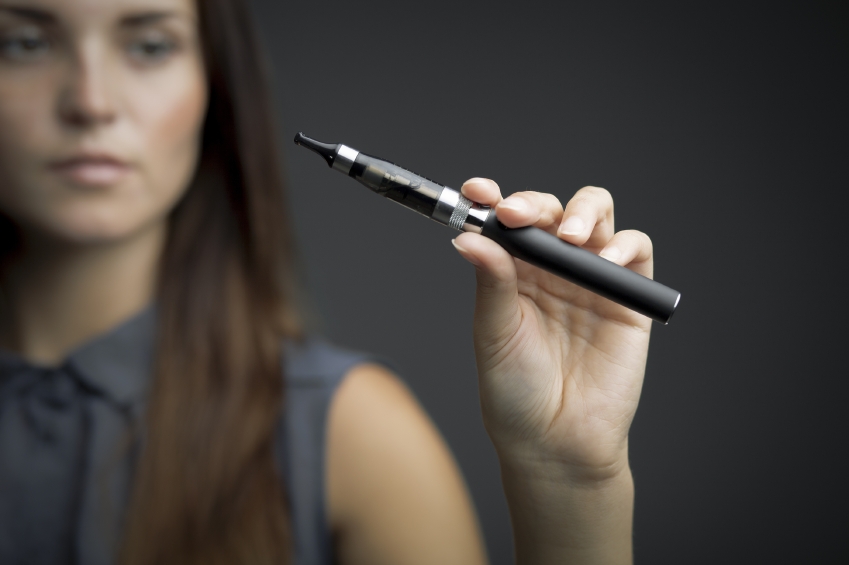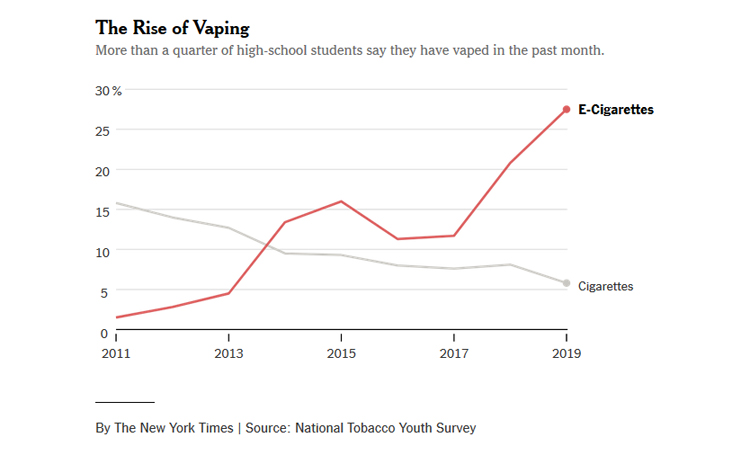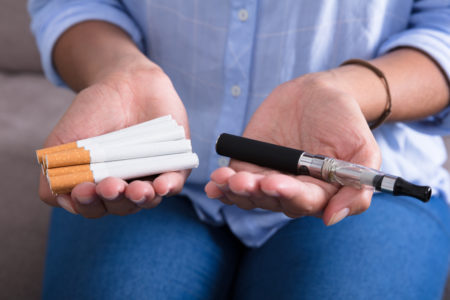
Share On Social!
Amid mounting health concerns over teen vaping, the U.S. Congress voted on Dec. 19, 2019, to raise the purchasing age for all tobacco products—including e-cigarettes—from 18 to 21, the New York Times reports.
President Trump is expected to sign the measure on Dec. 20, 2019.
Experts say raising the purchasing age will reduce the number of people who begin smoking at very young age. Nearly 9 out of 10 smokers started smoking by age 18.
 The rule is also a response to deadly health concerns over teen vaping.
The rule is also a response to deadly health concerns over teen vaping.
The CDC announced in December 2019 that 54 people died and 2,506 cases of lung-related illnesses had been reported due to vaping.
“Raising the tobacco age to 21 is a positive step, but it is not a substitute for prohibiting the flavored e-cigarettes that are luring and addicting our kids,” Campaign For Tobacco-Free Kids media director Dave Lemmon said in an email statement to Forbes.
How Popular Are E-Cigs among Teens and Young Adults?
E-cigarettes have been exceptionally popular with youth, in part due to companies’ aggressive marketing campaigns.
Several types of e-cigarette devices have become widely available over the past 10 years. E-cigarette maker JUUL Labs has been a roaring success in recent years, becoming the fastest startup to reach a valuation of over $10 billion and drawing an FDA crackdown.
 Bitterness and smoothness may be cross-cutting mediators of inter-product variation in the effects of types of non-tobacco flavours and nicotine on e-cigarette appeal in young adults. Appeal-enhancing effects of fruit and appeal-reducing effects of nicotine boost their popularity among young adults.
Bitterness and smoothness may be cross-cutting mediators of inter-product variation in the effects of types of non-tobacco flavours and nicotine on e-cigarette appeal in young adults. Appeal-enhancing effects of fruit and appeal-reducing effects of nicotine boost their popularity among young adults.
Just how popular are e-cigarettes?
- Overall, teen e-cigarette use doubled since 2017, according to a September 2019 University of Michigan study.
- In 2018, CDC and FDA data showed that more than 3.6 million U.S. youth, including 1 in 5 high school students and 1 in 20 middle school students, used e-cigarettes in the previous month.
- The CDC reports that more than 1 of every 4 high school students (27.5%) reported in 2019 that they used electronic cigarettes in the past 30 days.
In Ohio last year, over 20% of retailers who were inspected by the state were found to have sold cigarettes to minors, violating state and federal law, Micah Berman of The Ohio State University, told the New York Times.
Little is known about how e-cigarette uptake and use patterns differ across race/ethnicity and socioeconomic status.
The American Heart Association reports that young Latinos are increasingly using e-cigarettes. Also, among non-smokers of conventional cigarettes, higher odds of ever using e-cigarettes were observed for younger adults than older adults, among males than females, and among Mexican American/Hispanic study participants than non-Hispanic whites, according to a study in Journal of Health Care.
New vaping devices continue to enter the market rapidly. But safety and long-term health effects are still a matter of considerable scientific debate.
 E- cigarettes and Teen Health
E- cigarettes and Teen Health
As the popularity of e-cigarettes has surged in recent years, so has the public’s confusion over the health risks these products pose.
The U.S. surgeon general called teen vaping a national health epidemic.
Studies are rising on the dangers of e-cigarettes:
- Exposure to e-cig ads increased the likelihood of future e-cigarette use. Exposure to e-cig marketing also was associated with the use of conventional cigarettes, according to a November 2019 study.
- The National Institutes of Health also report that e-cigarettes lead more kids to smoke.
- Worse, e-cigarettes pose potential to harm users. A recent study from New York University showed that e-cigarette vapor causes lung cancer and potentially bladder cancer in mice and damaging their DNA. The study found that 9 of 40 mice exposed to E-cig smoke with nicotine for 54 weeks developed lung adenocarcinomas.
- The latest study, published Dec. 16, 2019, in the American Journal of Preventive Medicine, found that people who reported using the devices were more likely to develop lung illnesses such as chronic obstructive pulmonary disease (COPD), chronic bronchitis, emphysema or asthma.
On Jan 09, 2020, Senetor Sherrod Brown introduces senate version of comprehensive legislation to reverese e-cigarette epidemic to reverse the youth e-cigarette epidemic that is sweeping across the country and to continue to drive down youth tobacco use.
According to another recent study in Public Health, the high prevalence of e-cigarette smoking is also linked as a gateway for alcohol drinking in adolescents, especially among racial minorities.
Raising the purchasing age is one attempt to address these health concerns.
“Nineteen states and more than 500 cities and towns have already raised the age to 21. Setting it as a national age limit is viewed as an effort to appease those who are calling for a full ban on e-cigarettes or a flavor ban to prevent addicting a new generation to nicotine,” according to the New York Times. “While many lawmakers and public health experts welcomed a higher age limit for sales of cigarette items, others argue that tougher enforcement of sales laws, as well as higher taxes on products, are also needed to deter teenage use.”
‘Quitxt’ Can Help You to Quit Smoking
While e-cigarettes continue to create controversy, we know the scientific facts about the dangers of cigarette smoking.
If you are interested in quitting cigarettes, we would invite you to join Quitxt.
The Quitxt program is a bilingual service that sends texts with culturally and regionally tailored support to help South Texas young adults quit smoking.
The service uses text messages, and Facebook Messenger chat to help with motivation to quit, setting a quit date, finding things to do instead of smoking, handling stress, using nicotine replacement if needed, and more. The service was created by Amelie G. Ramirez, leader of Salud America! at the Institute for Health Promotion Research at UT Health San Antonio.
Learn more about Quitxt text-message program in English or Spanish to help you quit smoking today!
Explore More:
AccessBy The Numbers
142
Percent
Expected rise in Latino cancer cases in coming years



